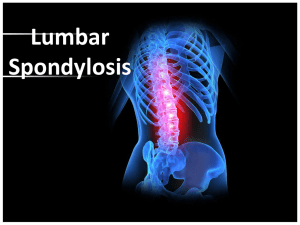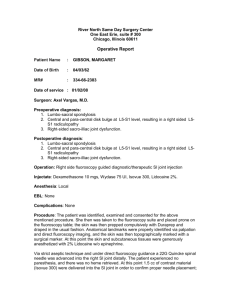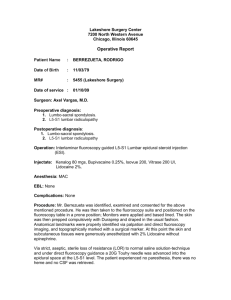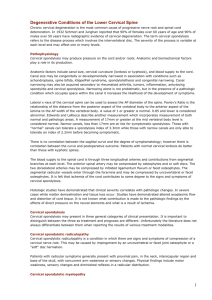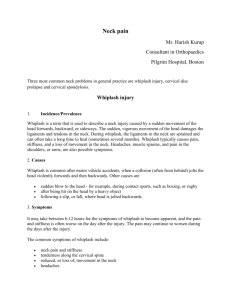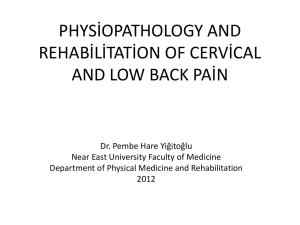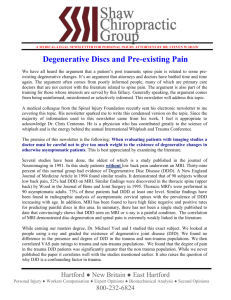Doc - Shaw Chiropractic
advertisement
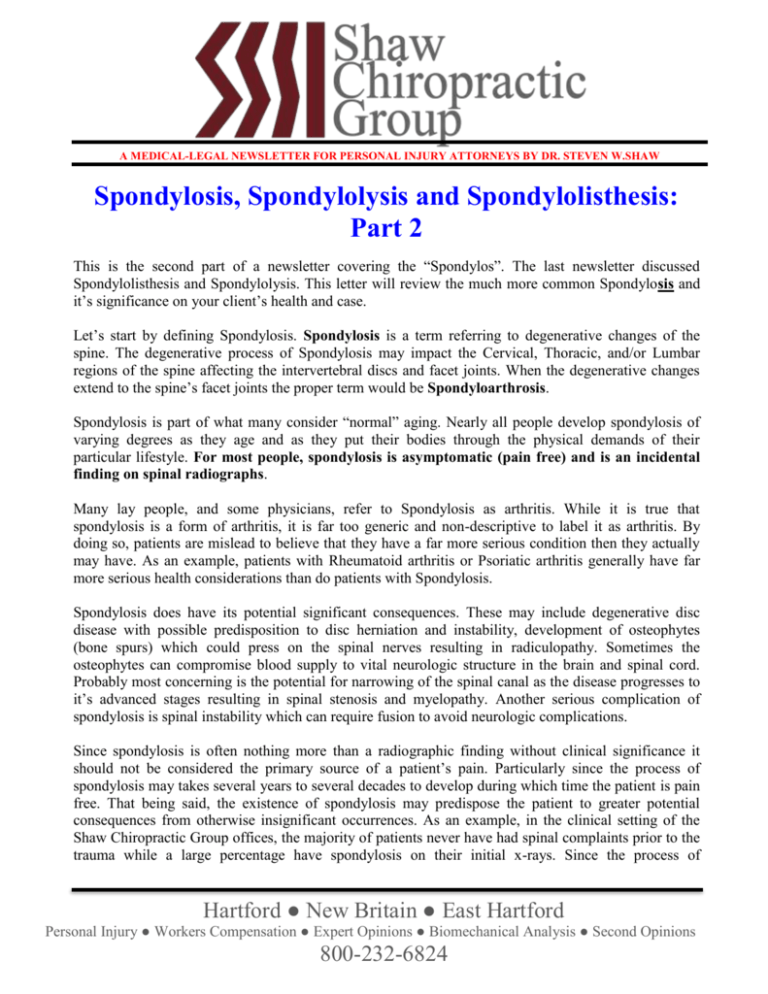
A MEDICAL-LEGAL NEWSLETTER FOR PERSONAL INJURY ATTORNEYS BY DR. STEVEN W.SHAW Spondylosis, Spondylolysis and Spondylolisthesis: Part 2 This is the second part of a newsletter covering the “Spondylos”. The last newsletter discussed Spondylolisthesis and Spondylolysis. This letter will review the much more common Spondylosis and it’s significance on your client’s health and case. Let’s start by defining Spondylosis. Spondylosis is a term referring to degenerative changes of the spine. The degenerative process of Spondylosis may impact the Cervical, Thoracic, and/or Lumbar regions of the spine affecting the intervertebral discs and facet joints. When the degenerative changes extend to the spine’s facet joints the proper term would be Spondyloarthrosis. Spondylosis is part of what many consider “normal” aging. Nearly all people develop spondylosis of varying degrees as they age and as they put their bodies through the physical demands of their particular lifestyle. For most people, spondylosis is asymptomatic (pain free) and is an incidental finding on spinal radiographs. Many lay people, and some physicians, refer to Spondylosis as arthritis. While it is true that spondylosis is a form of arthritis, it is far too generic and non-descriptive to label it as arthritis. By doing so, patients are mislead to believe that they have a far more serious condition then they actually may have. As an example, patients with Rheumatoid arthritis or Psoriatic arthritis generally have far more serious health considerations than do patients with Spondylosis. Spondylosis does have its potential significant consequences. These may include degenerative disc disease with possible predisposition to disc herniation and instability, development of osteophytes (bone spurs) which could press on the spinal nerves resulting in radiculopathy. Sometimes the osteophytes can compromise blood supply to vital neurologic structure in the brain and spinal cord. Probably most concerning is the potential for narrowing of the spinal canal as the disease progresses to it’s advanced stages resulting in spinal stenosis and myelopathy. Another serious complication of spondylosis is spinal instability which can require fusion to avoid neurologic complications. Since spondylosis is often nothing more than a radiographic finding without clinical significance it should not be considered the primary source of a patient’s pain. Particularly since the process of spondylosis may takes several years to several decades to develop during which time the patient is pain free. That being said, the existence of spondylosis may predispose the patient to greater potential consequences from otherwise insignificant occurrences. As an example, in the clinical setting of the Shaw Chiropractic Group offices, the majority of patients never have had spinal complaints prior to the trauma while a large percentage have spondylosis on their initial x-rays. Since the process of Hartford ● New Britain ● East Hartford Personal Injury ● Workers Compensation ● Expert Opinions ● Biomechanical Analysis ● Second Opinions 800-232-6824 A MEDICAL-LEGAL NEWSLETTER FOR PERSONAL INJURY ATTORNEYS BY DR. STEVEN W.SHAW spondylosis is many years in the making, it is clear that the spondylosis is not the primary causation of their pain. Several years ago, Dr. Yoel and I participated in a masters degree program in biomechanical trauma. The research for our masters thesis concerned the relationship of Spondylosis to pain on subjects with and without trauma. The paper was titled The Effect of Cervical Spondylosis and Trauma on Neck Pain. The findings of the investigation suggested that the presence of cervical spondylosis in non-trauma subjects is not related to pain. More important, the research revealed that the presence of cervical spondylosis in trauma subjects results in a statistically significant increase in pain scale rating than for non- spondyloisis subjects in similar trauma. It is important for the doctor, patient and attorney to appreciate the trauma relationship to spondylosis. For most patients, the presence of spondylosis is a complicating factor which predisposes the patient to far greater injury potential. This complication may result in greater injury, longer recovery, less desirable outcome and greater physical impairment. It is a misrepresentation for the doctor, attorney or carrier to suggest to a patient that the spondylosis resulted in the pain and impairment if the patient has no history of spine pain prior to the trauma. In a similar fashion, Diabetic patients also have complications resulting in greater injury, longer recovery and greater impairments. Who would blame the post traumatic pain on the diabetes? Hartford ● New Britain ● East Hartford Personal Injury ● Workers Compensation ● Expert Opinions ● Biomechanical Analysis ● Second Opinions 800-232-6824
